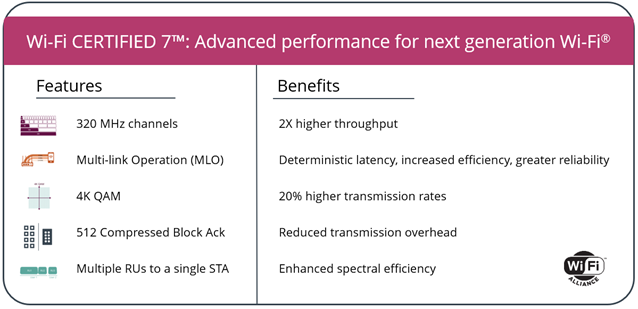Getty Images
Wi-Fi 7 devices can now be certified by the Wi-Fi Alliance. The new standard can provide higher throughput, linked wireless bands for better stability, and reduced latency. It also can make people who skipped over Wi-Fi 6E feel like they made the smart move.
Wi-Fi 7 has already existed as a thing that expensive, new routers claimed to offer, but now it’s a certification they can claim. Wi-Fi 7 devices can use 320 MHz of channel bandwidth, compared to the typical 160 MHz used by Wi-Fi 5, 6, and 6E gear. The new standard is the first to offer Multi-Link Operation, which can bond a connection across 2.4, 5, and 6 GHz connections, offering greater speed and more reliable connections when moving in and out of range of various bands.
Intel’s explainer for what Wi-Fi 7 means, compared to prior generations.
Intel
As Intel puts it in its explainer, earlier Wi-Fi channels were like moving vans that could “only take one highway at a time and choose alternate routes if they run into traffic. However, Wi-Fi 7 semi-trucks will simultaneously operate across two highways to get more boxes to the destination more quickly.”
Then there’s Multi-Resource-Unit Puncturing, a deeply inelegant term that yet seems useful. In essence, Wi-Fi 7 allows for unused parts of the higher-speed channels to be used, whereas Wi-Fi 6 and 6E cannot share the richest parts of their 6 GHz spectrum. Intel’s house-moving analogy is that Wi-Fi 7 movers can “re-pack most of the semi-truck contents into smaller trucks,” then using different lanes on a highway to transport the goods.

Wi-Fi 7 features, as enumerated by the Wi-Fi Alliance.
Wi-Fi Alliance
All this means that, in ideal and mostly irrelevant circumstances, a Wi-Fi 7 device could achieve a 5.8Gbps connection, presuming several things about all the other parts of that connection. Wi-Fi 7, generally, has a maximum throughput of roughly 36Gbps. Even more theoretically, the new 16×16 MU-MIMO capabilities mean that a Wi-Fi 7 router with 16 antennas could send 16 data streams to 16 devices, even if almost no consumer-level devices or routers will provide that kind of connectivity. Still, the higher ceiling should make for a better general experience.
Before Wi-Fi 7 became official this week, manufacturers were already touting devices that were pending its certification. The TP-Link Archer BE800 (or sometimes BE19000) is the most striking of them, looking like it comes from some hard-edged future and costs $600. Samsung’s Galaxy S23 Ultra and its Qualcomm FastConnect 7800 chip have Wi-Fi 7 capability, though Samsung would need to enable it through a software update.
Wi-Fi 6E devices were, for a time, tough to come by due to component shortages lasting through the tail end of the COVID-19 pandemic. It should be a different landscape for Wi-Fi 7, which offers some real upgrade incentives over prior generations. Now, broadband service across the US just needs to catch up.
